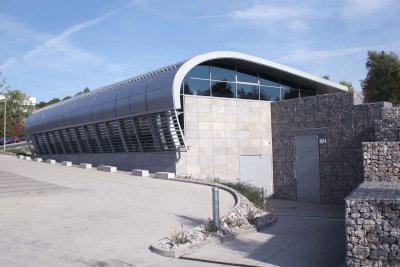Facilities
Göttingen High Pressure Turbulence Facility

Investigations of the fundamental properties of turbulence require flows with high Reynolds numbers under well-controlled conditions. The flow properties need to be resolvable by modern measurement technology from the largest to the smallest spatial and temporal scales. On Earth the highest turbulence levels (Reynolds numbers = 10 7) are found in the atmospheric boundary layer. Even the most violent flows on Earth, such as plinian volcanic eruptions, have similar turbulence levels.
The observations of natural flows are difficult, as the conditions are rarely stationary and the scales of the flow are very large and make detailed measurements utmost difficult. For example, when considering the turbulent motion of clouds in the atmospheric boundary layer, the largest scales of the flow are typically 100 meters, while the smallest scales are fractions of millimeters. Another complication is that clouds are carried by a mean wind. With current measurement technology it is very difficult, if not impossible, to resolve all scales of the dynamics of turbulent clouds. In addition, the turbulence generation mechanisms in nature are multifold and it is difficult to investigate how the turbulence depends on its generation mechanisms. In the foreseeable future computational Fluid Physics can substitute experiments only for moderate Reynolds numbers at idealized flow conditions. Therfore, experimental facilities generating turbulent flow fields at high Reynolds numbers are essential for research.
The properties of turbulence can either be measured from the spatial (Eulerian) perspective or from the perspective of particles carried by the flow, the so-called Lagrangian perspective. While Eulerian measurements have traditionally been conducted in wind tunnels with hot wire anemomentry, only recently it has become possible to conduct Lagrangian measurements with high accuracy at high Reynolds numbers thanks to the advance in imaging technology.
High Reynolds numbers at managable temporal and spatial scales under well-controlled conditions can be realized by employing the principle of physical self-similarity. The turbulence Reynolds number scales as Re= ρ v L/ η, where ρ is the density of the fluid, v is the fluctuating velocity, L is the energy injection scale and η is the molecular dynamical viscosity.
One way to achieve high Reynolds numbers is to use cryogenic He gas. In this case very high Reynolds numbers can be achieved, however, with very small spatial and temporal scales that currently cannot be fully resolved by measurement technology. In addition, many methods well tested at room temperature are difficult to use at cryogenic temperatures.
An alternative way is to increase the density by pressurizing the gas. This increases the Reynolds numbers, as the molecular dynamical viscosity is approximately independent of pressure. In addition, by using a heavy gas, like sulfur hexafluoride (SF6) it is possible to reach high Reynolds numbers already at moderate pressures of only 10-20 bar.
In Göttingen we have decided to go the second path. We have
installed
two facilities that pressurize SF6 gas at up to 19 bar.
The institute installed a gas handling and liquefaction system
that handels and stores 12 tons of SF6. The gas is used
in two facilities: the
![]() Göttingen Turbulence Tunnel
and the
Göttingen Turbulence Tunnel
and the
![]() Göttingen U-Boot.
While the first is a wind tunnel with extra long measurement
sections to allow particle tracking in the decaying tirbulence
behind a passive or active grid, the latter is used for the
investigations in Lagrangian mixers and of turbulent thermal
convection. In addition to serving the in-house experimentalists,
the Göttingen High Pressure Turbulence Facility provides
visitors with the possibility to study phenomena in turbulent
flows under well controlled conditions at high Reynolds and
Rayleigh numbers.
Göttingen U-Boot.
While the first is a wind tunnel with extra long measurement
sections to allow particle tracking in the decaying tirbulence
behind a passive or active grid, the latter is used for the
investigations in Lagrangian mixers and of turbulent thermal
convection. In addition to serving the in-house experimentalists,
the Göttingen High Pressure Turbulence Facility provides
visitors with the possibility to study phenomena in turbulent
flows under well controlled conditions at high Reynolds and
Rayleigh numbers.
Further information can be found at
